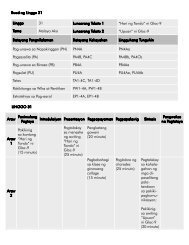Lesson 1 How Others See Me
LP_Second_Quarter_Grade_7_English - baitang7
LP_Second_Quarter_Grade_7_English - baitang7
- No tags were found...
Create successful ePaper yourself
Turn your PDF publications into a flip-book with our unique Google optimized e-Paper software.
Task 7. Analyzing Situations<br />
The featured reading text presents several situations that could represent the<br />
concepts below. Study the provided descriptions and participate in a discussion led by<br />
the teacher.<br />
A paradox is basically a sentence that presents a situation that defies logic or the<br />
usual way things are expected to be. Despite this, the idea presented remains true. An<br />
example is : One has to die in order to live.<br />
An irony is said to be present when the presented meaning of a message is<br />
different from the one that is truly intended (verbal irony). This is also associated with<br />
sarcasm or mockery (e.g. Saying ―I‘m so happy‖ when one is truly sad.). Irony is also<br />
observed in the theatre (dramatic or literary irony) when ―the audience knows more<br />
about the situation than the characters‖ 1 and this ignorance causes several conflicts.<br />
Situational irony is manifested when one does something for a specific reason but is<br />
met with a result that contradicts his intention (e.g. Exercising strenuously to be healthy<br />
but ending up ill because of exhaustion.)<br />
An oxymoron is a phrase or a two-word description where the two words contrast<br />
with each other (e.g. deafening silence, sweet sorrow, etc.). An oxymoron can be<br />
considered as a paradox reduced to two words.<br />
Review the story and your output for Task 6 (Predicting Population Trends) and<br />
give 1-2 instances that present a paradox and 1-2 cases of irony. Then, create or cite<br />
an oxymoron that can describe any of the instances you gave. Write your answers on a<br />
sheet of paper.<br />
Task 8. Giving Assumptions and Predictions (Part 2)<br />
Recall what you did for Task 3. You will do the same for this activity using a<br />
different text. Listen carefully as the teacher reads a text twice. List down assumptions<br />
and predictions for the first listening segment. Pay attention to supporting details for<br />
your assumptions and predictions during the second listening segment. Present your<br />
answers using the table on the next page. Copy this on a sheet of paper.<br />
Assumptions Supporting Lines Predictions Supporting<br />
Lines<br />
1. 1.<br />
2. 2.<br />
3. 3.<br />
1 Differencebetween.net<br />
Grade 7 English Learning Package 68









